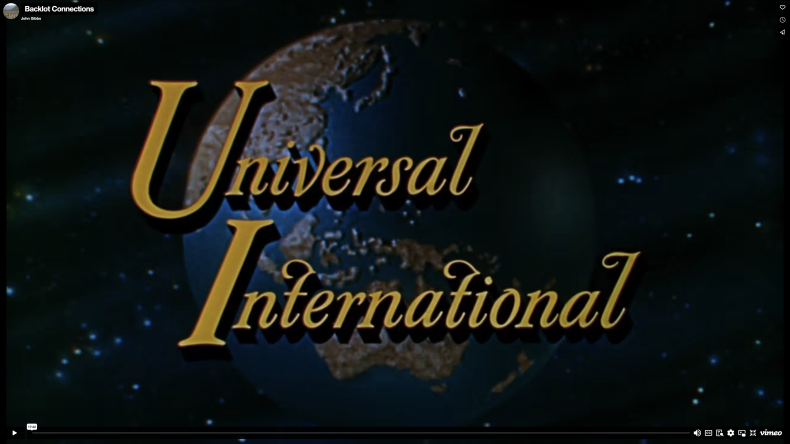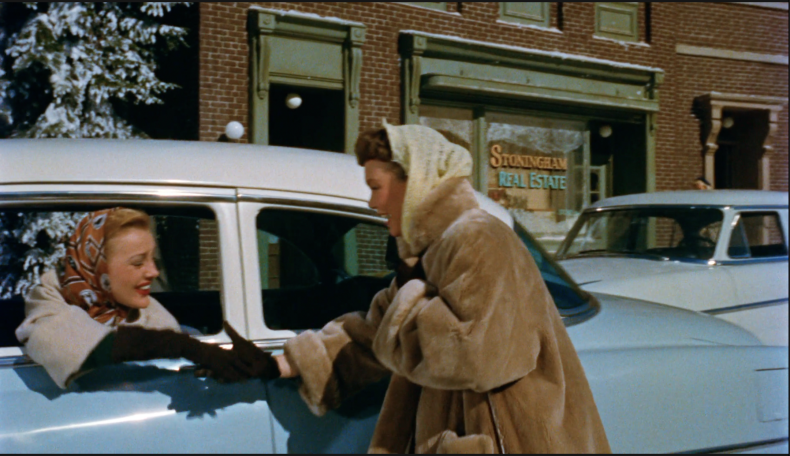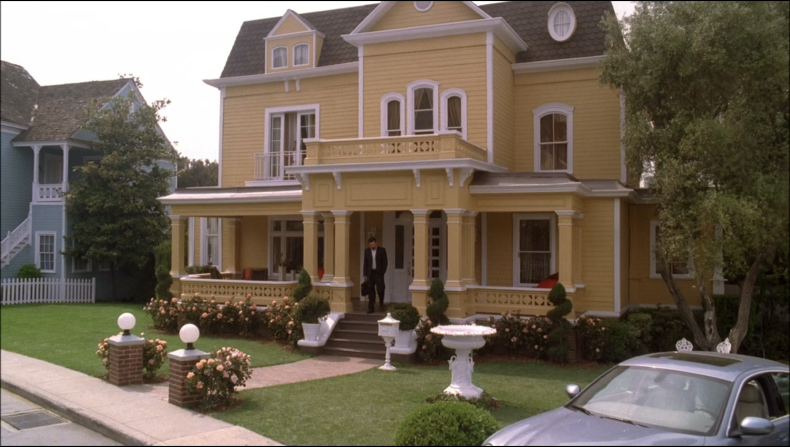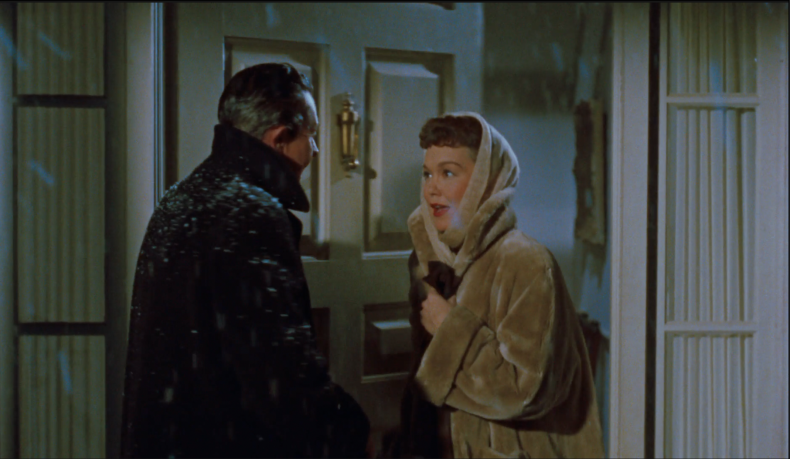Backlot Connections
This is an Open Access article distributed under the terms of the CC BY-NC-ND 4.0 License.
Suggested Citation: Gibbs, John. “Backlot Connections.” In Research in Film and History (2025): 1-14. http://dx.doi.org/10.25969/mediarep/23838.
A Creator’s Statement in 12 Parts
Opening
It was an extended period of viewing and studying films directed by Douglas Sirk that first interested me in movies shot on the Universal Backlot, both in their reuse of standing sets and the suggestive and surprising relationships that such practical redeployment might make visible. Initially, I was struck that Jane Wyman’s character Cary Scott in ALL THAT HEAVEN ALLOWS (1955) and Barbara Stanwyck’s Naomi Murdoch in ALL I DESIRE (1953) are next-door neighbours, encountering similar social pressures as mothers in small town melodramas, though in different fictional towns, forty fictional years apart. This led me to notice other relationships and, at some point after becoming a video essayist, the idea of cutting different films together into a creative geography that gave historical connections and thematic parallels new life began to take shape. Murray Pomerance, who saw an early presentation around this work, and who knows a thing or two about movie backdrops, holds the view that the films were available for such a short period at the time of their release that it would have been very difficult for audiences to recognise the similarities of setting in the way that the BACKLOT CONNECTIONS encourages. But repeated viewing, in the context of academic (or fan) engagement – via Prevost and Steenbeck, then VHS, DVD, Blu-Ray – opens new perspectives.1 And now the opportunity to play with digital files, and recut them in readily accessible non-linear editing programmes, enables further opportunities for scrutiny – and elaboration.
Parameters
I have restricted the material presented in BACKLOT CONNECTIONS to films made or set in the fifties. I have also focussed on those set in small towns, across a number of genres. Hannah Piekarz, who collected sequences from films and television programmes shot on the Backlot as a research assistant on the project, argued, on seeing a draft, “the main theme is how the Universal streets represent all of small town America.” At the suggestion of Christian Keathley on the same draft, I withheld the films’ names until the end credits – which contributes to the sense that these characters’ lives are lived adjacent to each other, in a collective, continuous space.2 In BACK TO THE FUTURE (1985), Doc Brown responds in 1955 on hearing who the president is in 1985: “Ronald Reagan! The actor? … Then who’s Vice-President? Jerry Lewis? … I suppose Jane Wyman is the first lady!” BACKLOT CONNECTIONS pictures Reagan and Wyman living in adjacent plots on New England Street – though they were no longer married by the time of BEDTIME FOR BONZO (1951) or ALL THAT HEAVEN ALLOWS, nor when Doc voices his incredulity – not to mention Jerry Lewis’ disastrous installation work for Midvale T.V. two doors along.
Unlike Christian Marclay’s THE CLOCK (2010), and countless television documentaries, BACKLOT CONNECTIONS preserves the original aspect ratios of the films it works with. This is historically, aesthetically and semantically important, to my mind, and also not difficult to accommodate as a viewer, to my eye. I hope you agree.
Art Directors and Set Decorators
The Universal International pictures that appear in BACKLOT CONNECTIONS were made during the long career of Art Director extraordinaire, Alexander Golitzen, who has 339 credits on IMDB, including ALL I DESIRE, ALL THAT HEAVEN ALLOWS and WRITTEN ON THE WIND (1956). Bernard Herzbrun shares the Art Director credit on ALL I DESIRE and also worked on HAS ANYBODY SEEN MY GAL (1952), BEDTIME FOR BONZO and HARVEY (1950). Russell A. Gausman, Set Decorator, who IMDB credits with 765 films and television programmes, worked on all of the above.3 Julia Heron, Set Decorator, 152 credits on IMDB (a figure which disguises extensive television work, including 82 episodes across Hitchcock’s two series), worked on four of the films listed here, including three directed by Sirk. It is only as we move toward independent production (and Paramount’s incursion on the Universal back lot, see below) that the key players in the Universal Art Department are not involved in the films featured.
THE DESPERATE HOURS (1955) and ALL THAT HEAVEN ALLOWS were released three months apart but the house that is the central setting in both grows a balcony and portico between the two; in ROCK-A-BYE BABY (1958) the balcony remains but the dormers have changed shape. Despite the continuities that BACKLOT CONNECTIONS traces, the Lot is in a continual state of minor redevelopment. If you look across the video, the building which is Hilverton library in HAS ANYBODY SEEN MY GAL is a church in ALL I DESIRE, has no tower in HARVEY, the tower in place for its appearance as Fairvale Church in PSYCHO (1960).
A very similar tower, though without finials, appears suspended on the opposite side of Circle Drive in the opening of ALL THAT HEAVEN ALLOWS, and of this video essay, although the church can be glimpsed behind the credits as the camera begins to pan left and tilt down. In the two images below – both from ALL THAT HEAVEN ALLOWS, the same Circle Drive shopfront appears as both Stoningham’s Butcher and its Real Estate Agent, careful framing and a different angle helping to achieve the sleight of hand.
Gone but not Forgotten
Circle Drive no longer exists. Neither do the spaces of New England Street and Colonial Street: they have been turned over to parking and studio buildings. Courthouse Square, which was constructed in 1948 for AN ACT OF MURDER, and known for some years prior to BACK TO THE FUTURE as Mockingbird Square because of its prominence in TO KILL A MOCKINGBIRD (1962), was substantially affected by at least three of the fires that have been a regular occurrence in the history of the Lot, though the courthouse façade has on each occasion escaped relatively untouched. A number of the houses from Colonial Street and New England Street still exist, nevertheless, moved to a less well situated part of the Backlot, another iteration of “Colonial Street” which is now better known as Wisteria Lane. The remains of the Harvey House – sans tower, transposed – provide the home lived in by Gabrielle (Eva Longoria) in DESPERATE HOUSEWIVES (2004–2012).
Houses and Names that Endure
What this video refers to as the Murdoch house was known on the Lot as the Dana House and Cary Scott’s house was called the Paramount House, because Paramount Pictures built it at Universal for THE DESPERATE HOURS. The Harvey House was indeed known as the Harvey House, and Ron’s Barn, the building that Rock Hudson’s character develops into a home in ALL THAT HEAVEN ALLOWS (which we don’t see in BACKLOT CONNECTIONS) retains this name through a number of redevelopments. Timotheus Vermeulen and others have noted that one of the reuses of the Barn is as the home of Susan, Teri Hatcher’s character in DESPERATE HOUSEWIVES.4
Character Connections
Rock Hudson, as well as embodying the alternative to small town life offered by Ron Kirby in ALL THAT HEAVEN ALLOWS, plays Mitch Wayne in WRITTEN ON THE WIND. For both Kyle and Marylee Hadley, Mitch represents a kind of American masculinity they desire but can’t attain; Babington and Evans, in their article “All that Heaven Allowed: Another Look at Sirkian Irony,” describe Mitch as “a figure associated with the primitive virtues of pastoral America, [if] hardly now wholeheartedly embodying them.”5 In BACKLOT CONNECTIONS’ reworking, Marylee’s stone throwing is not answered by Mitch but rather Dutch, Naomi’s former lover from ALL I DESIRE, also associated with masculine prowess, nature, and representing (something of) an alternative to the small town, but a poor substitute for Rock Hudson.
Had the material and my parameters permitted, I would have liked to make more of television as a motif. In BACKLOT CONNECTIONS we see Clayton installing a (rather unusual) TV aerial for Mrs Van Cleeve and the text onscreen alludes to the role that purchasing a television plays in the attempt by Cary’s children and the wider Stoningham community to enforce her widowhood, confined to her house, in opposition to a vibrant life she might pursue outside with Ron. The key moments in this motif are shot in the studio, however, rather than on the Backlot. Cary’s house – the Paramount house – lives on in many people’s televisual imagination as the family home in LEAVE IT TO BEAVER (1957–1963 – though only shot on the Universal Lot from series 3 onwards).
Precedents and Similar Projects
I hadn’t read Mark Rappaport’s “The Secret Life of Objects” before Christian Keathley pointed it out to me part way through working on this project, but it is clearly a parallel enquiry. (I had seen his video essay about THE VANITY TABLES OF DOUGLAS SIRK (2015), also a related endeavour.) “The Secret Life of Objects” charts the appearance of various props and elements of scenery across films; it is fascinating and offers some of the same pleasures of belated recognition which apply here. However, BACKLOT CONNECTIONS pushes beyond a catalogue to suggest some of the associations and meanings running through the connections uncovered, especially for the viewer familiar with the debates around these movies, some of which are central to the study of Classical Hollywood (and wider film studies), and some less so (which has its own value).6
There is also a relationship to found footage films that have concerned themselves with the places movies are shot. LOS ANGELES PLAYS ITSELF (Thom Andersen, 2003) would be one example, as would Richard Misek’s ROHMER IN PARIS (2013), another mapping project that uses the material of the object of study to construct a geography, though in these cases locations are the focus rather than standing sets.
Ending with PSYCHO seems appropriate
A film shot at the end of 1959 into early 1960, it brings my period to an end but also represents the end of the studio system and the mode of production that shaped most of the films in BACKLOT CONNECTIONS. It is impossible to better Laura Mulvey on PSYCHO’s significance in this regard:
The crisis in the old Hollywood film industry, caught at the crossroads, faced with its own mortality, gave [Hitchcock] the opportunity to write its epitaph, but also to transcend its conventions and create something startling and new. With a return to the studio and black-and-white film stock, PSYCHO harks back to an earlier era for Hollywood, but its low budget, scaled-down production values chimed with the emergence of new forces: television, of course, but also a low-budget American independents and European art cinema. The film produces a sense of the ‘new’ out of a rearrangement of the old, reusing narrative and other motifs that are familiar from across the body of Hitchcock’s work.7
Shamley productions, the company Hitchcock established for his television series, had a permanent home at Universal, and it was the regular crew from these shows that PSYCHO primarily employed, while his high-end contract with Paramount provided the home for his film productions.
Acknowledgements
In addition to the people thanked in the end credits, and to the books and articles cited below, I would like to the acknowledge the work of enthusiasts and historians who have posted information about the Universal Backlot on various websites. Jon Primrose’s TheStudioTour.com provided very useful leads and information, as did the Universal City section of the Studio Backlots website, and especially Universal Stone Cutter, the monumental collection of Flickr pages assembled by Dennis Dickens, which contain a wealth of photographs and other visual materials. Since completing the video I have encountered Phantom of the Backlots, the blog by Donnie Norden.
Burbank Peak
I was partly drawn to this project by Burbank Peak, which forms the backdrop to many small towns in Universal movies. The scar on the side of the hill, created to carry a powerline (but also now a walking trail), is its most distinctive feature. I’ve never visited Universal Studios in real life, but if I do, I shall also make a point of walking up Burbank Peak, along Powerline Trail to the Wisdom Tree, and looking back.
- 1
As Laura Mulvey, and others, have described. See Laura Mulvey, “Repetition and Return: Textual Analysis and Douglas Sirk in the Twenty-First Century,” in Style and Meaning: Studies in the Detailed Analysis of Film, ed. John Gibbs and Douglas Pye (Manchester: MUP, 2005), 229–230.
- 2
As Jonathan Bignell put it in correspondence, BACKLOT CONNECTIONS offers “a concrete instance of the idea of ‘Hollywood’ as both a place and a shared state of mind (or a shared set of ideological premises, if you will).” In his article “Transatlantic Spaces: Production, Location and Style in 1960s–1970s Action-Adventure TV Series,” Bignell argues that across numerous television series the reuse of the villages, houses and streets outside Elstree Studios and buildings on Elstree’s backlot – Avengerland, as it became known – created a similar sense of an alternate reality that multiple fictions seem to share: “What the programmes made at Elstree did was to aesthetically and narratively link these symbolic spaces as a hybrid imagined geography.” In Jonathan Bignell, “Transatlantic Spaces: Production, Location and Style in 1960s–1970s Action-Adventure TV Series,” Media History 16, no. 1 (2010): 59.
- 3
Golitzen and Gausman also worked together on LETTER FROM AN UNKNOWN WOMAN (Max Ophuls, 1948), TOUCH OF EVIL (Orson Welles, 1958) and many films directed by Douglas Sirk. Both Gausman and Heron won Academy Awards for their work, including with Golitzen on SPARTACUS (1960).
- 4
Conflating New England Street and Colonial Street, and the two iterations of Colonial Street – which is what the Studios have also done – Vermeulen writes: “What is interesting is that Wisteria Lane is at once a re-appropriation of Colonial Street and of Ron’s old mill. After all, in ALL THAT HEAVEN ALLOWS, the two locations are spatially, socially and psychologically separated from one another. For one, Colonial Street is located near the centre of town, while Ron’s mill is situated in the countryside. More importantly still, Colonial Street is associated with bourgeois order, etiquette and artificiality, whereas Ron’s mill connotes a Thoreauesque freedom of class, mores and manner.” In Timotheus Vermeulen, Scenes from the Suburbs: The Suburb in Contemporary US Film and Television (Edinburgh: EUP, 2014), 111.
- 5
Bruce Babington and Peter William Evans, “All that Heaven Allowed: Another Look at Sirkian Irony,” Movie 34/35 (1990): 53.
- 6
It’s also the case that Robin Wood noted that the staircase and hallway which appear briefly in this essay (and prominently in WRITTEN ON THE WIND) is the setting for a key scene in MARNIE (Alfred Hitchcock, 1964) (See Robin Wood, “Written on the Wind,” in The Oxford Guide to Film Studies, ed. John Hill and Pamela Church Gibson (Oxford: Oxford University Press, 1974, 1998), 24). Peter William Evans lists a number of other films that make use of “this hallowed piece of the Universal set.” In Peter William Evans, Written on the Wind (London: BFI, 2013), 56–57.
- 7
Laura Mulvey, Death 24x a Second: Stillness and the Moving Image (London: Reaktion Books, 2006), 85.
Babington, Bruce, and Peter William Evans. “All that Heaven Allowed: Another Look at Sirkian Irony.” Movie 34/35 (1990): 48–58.
Bignell, Jonathan. “Transatlantic Spaces: Production, Location and Style in 1960s–1970s Action-Adventure TV Series.” Media History 16, no. 1 (2010): 53–65.
Evans, Peter William. Written on the Wind. London: BFI, 2013.
Mulvey, Laura. “Repetition and Return: Textual Analysis and Douglas Sirk in the Twenty-First Century.” In Style and Meaning: Studies in the Detailed Analysis of Film. Edited by John Gibbs and Douglas Pye, 228–243. Manchester: MUP, 2005.
Mulvey, Laura. Death 24x a Second: Stillness and the Moving Image. London: Reaktion Books, 2006.
Rappaport, Mark. “The Secret Life of Objects.” Rouge 13 (2009). http://www.rouge.com.au/13/secret.html.
Rebello, Stephen. Alfred Hitchcock and the Making of “Psycho.” New York: Dembner Books, 1990.
Vermeulen, Timotheus. Scenes from the Suburbs: The Suburb in Contemporary US Film and Television. Edinburgh: Edinburgh University Press, 2014.
Walker, Michael. “All I Desire (1953).” Movie 34/35 (Winter 1990): 31–47.
Wood, Robin. “Written on the Wind.” In The Oxford Guide to Film Studies. Edited by John Hill and Pamela Church Gibson, 24–26. Oxford: Oxford University Press, 1998.






